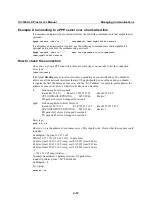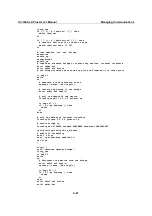
UC-7400-LX Plus User’s Manual
Managing Communications
4-14
4.
Edit the file
/etc/ppp/pap-secrets
and add the following:
“[email protected]” * “password” *
192.168.3.127 - PuTTY
support hostname “*” -
stats hostname “*” -
# OUTBOUND connections
# ATTENTION: The definitions here can allow users to login without a
# package already provides this option; make sure you don’t change that.
# INBOUND connections
# Every regular user can use PPP and has to use passwords from /etc/passwd
* hostname ““ *
“[email protected]” * “password” *
# PPPOE user example, if you want to use it, you need to unmark it and modify it
#”[email protected]” * “password” *
# UserIDs that cannot use PPP at all. Check your /etc/passwd and add any
# other accounts that should not be able to use pppd!
guest hostname “*” -
master hostname “*” -
root hostname “*” -
support hostname “*” -
stats hostname “*” -
“[email protected]” is
the username obtained from the ISP to log in to the ISP account.
“password”
is the corresponding password for the account.
5.
Edit the file
/etc/ppp/options
and add the following line:
plugin pppoe
192.168.3.127 - PuTTY
# Wait for up n milliseconds after the connect script finishes for a valid
# PPP packet from the peer. At the end of this time, or when a valid PPP
# packet is received from the peer, pppd will commence negotiation by
# sending its first LCP packet. The default value is 1000 (1 second).
# This wait period only applies if the connect or pty option is used.
#connect-delay <n>
# Load the pppoe plugin
plugin pppoe.so
# ---<End of File>---
6.
Add one of two files:
/etc/ppp/options.eth0
or
/etc/ppp/options.eth1
. The choice depends on
which LAN is connected to the ADSL modem. If you use LAN1 to connect to the ADSL
modem, then add
/etc/ppp/options.eth0
. If you use LAN2 to connect to the ADSL modem,
then add
/etc/ppp/options.eth1
. The file context is shown below:
192.168.3.127 - PuTTY
name [email protected]
mtu 1492
mru 1492
defaultroute
noipdefault
Type your username (the one you set in the
/etc/ppp/pap-secrets
and
/etc/ppp/chap-secrets
files) after the “name” option. You may add other options as desired.
















































